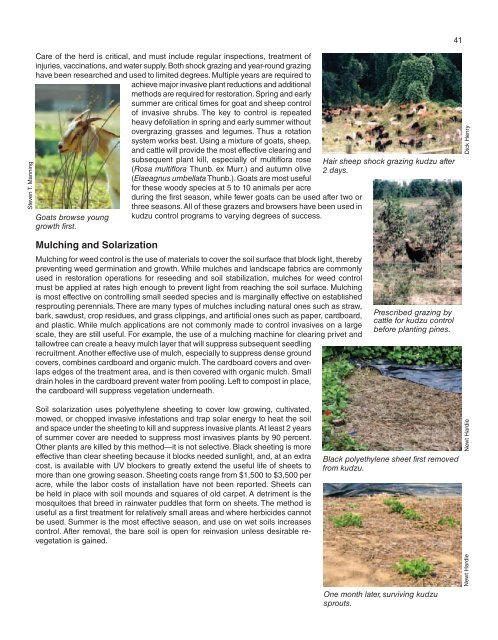A Management Guide for Invasive Plants in Southern Forests James ...
A Management Guide for Invasive Plants in Southern Forests James ...
A Management Guide for Invasive Plants in Southern Forests James ...
- No tags were found...
Create successful ePaper yourself
Turn your PDF publications into a flip-book with our unique Google optimized e-Paper software.
41Steven T. Mann<strong>in</strong>gCare of the herd is critical, and must <strong>in</strong>clude regular <strong>in</strong>spections, treatment of<strong>in</strong>juries, vacc<strong>in</strong>ations, and water supply. Both shock graz<strong>in</strong>g and year-round graz<strong>in</strong>ghave been researched and used to limited degrees. Multiple years are required toachieve major <strong>in</strong>vasive plant reductions and additionalmethods are required <strong>for</strong> restoration. Spr<strong>in</strong>g and earlysummer are critical times <strong>for</strong> goat and sheep controlof <strong>in</strong>vasive shrubs. The key to control is repeatedheavy defoliation <strong>in</strong> spr<strong>in</strong>g and early summer withoutovergraz<strong>in</strong>g grasses and legumes. Thus a rotationsystem works best. Us<strong>in</strong>g a mixture of goats, sheep,and cattle will provide the most effective clear<strong>in</strong>g andsubsequent plant kill, especially of multiflora rose(Rosa multiflora Thunb. ex Murr.) and autumn olive(Elaeagnus umbellata Thunb.). Goats are most useful<strong>for</strong> these woody species at 5 to 10 animals per acreGoats browse younggrowth first.dur<strong>in</strong>g the first season, while fewer goats can be used after two orthree seasons. All of these grazers and browsers have been used <strong>in</strong>kudzu control programs to vary<strong>in</strong>g degrees of success.Hair sheep shock graz<strong>in</strong>g kudzu after2 days.Dick HenryMulch<strong>in</strong>g and SolarizationMulch<strong>in</strong>g <strong>for</strong> weed control is the use of materials to cover the soil surface that block light, therebyprevent<strong>in</strong>g weed germ<strong>in</strong>ation and growth. While mulches and landscape fabrics are commonlyused <strong>in</strong> restoration operations <strong>for</strong> reseed<strong>in</strong>g and soil stabilization, mulches <strong>for</strong> weed controlmust be applied at rates high enough to prevent light from reach<strong>in</strong>g the soil surface. Mulch<strong>in</strong>gis most effective on controll<strong>in</strong>g small seeded species and is marg<strong>in</strong>ally effective on establishedresprout<strong>in</strong>g perennials. There are many types of mulches <strong>in</strong>clud<strong>in</strong>g natural ones such as straw,bark, sawdust, crop residues, and grass clipp<strong>in</strong>gs, and artificial ones such as paper, cardboard,and plastic. While mulch applications are not commonly made to control <strong>in</strong>vasives on a largescale, they are still useful. For example, the use of a mulch<strong>in</strong>g mach<strong>in</strong>e <strong>for</strong> clear<strong>in</strong>g privet andtallowtree can create a heavy mulch layer that will suppress subsequent seedl<strong>in</strong>grecruitment. Another effective use of mulch, especially to suppress dense groundcovers, comb<strong>in</strong>es cardboard and organic mulch. The cardboard covers and overlapsedges of the treatment area, and is then covered with organic mulch. Smalldra<strong>in</strong> holes <strong>in</strong> the cardboard prevent water from pool<strong>in</strong>g. Left to compost <strong>in</strong> place,the cardboard will suppress vegetation underneath.Prescribed graz<strong>in</strong>g bycattle <strong>for</strong> kudzu controlbe<strong>for</strong>e plant<strong>in</strong>g p<strong>in</strong>es.Soil solarization uses polyethylene sheet<strong>in</strong>g to cover low grow<strong>in</strong>g, cultivated,mowed, or chopped <strong>in</strong>vasive <strong>in</strong>festations and trap solar energy to heat the soiland space under the sheet<strong>in</strong>g to kill and suppress <strong>in</strong>vasive plants. At least 2 yearsof summer cover are needed to suppress most <strong>in</strong>vasives plants by 90 percent.Other plants are killed by this method—it is not selective. Black sheet<strong>in</strong>g is moreeffective than clear sheet<strong>in</strong>g because it blocks needed sunlight, and, at an extracost, is available with UV blockers to greatly extend the useful life of sheets tomore than one grow<strong>in</strong>g season. Sheet<strong>in</strong>g costs range from $1,500 to $3,500 peracre, while the labor costs of <strong>in</strong>stallation have not been reported. Sheets canbe held <strong>in</strong> place with soil mounds and squares of old carpet. A detriment is themosquitoes that breed <strong>in</strong> ra<strong>in</strong>water puddles that <strong>for</strong>m on sheets. The method isuseful as a first treatment <strong>for</strong> relatively small areas and where herbicides cannotbe used. Summer is the most effective season, and use on wet soils <strong>in</strong>creasescontrol. After removal, the bare soil is open <strong>for</strong> re<strong>in</strong>vasion unless desirable revegetationis ga<strong>in</strong>ed.Black polyethylene sheet first removedfrom kudzu.One month later, surviv<strong>in</strong>g kudzusprouts.Newt Hardie Newt Hardie
















